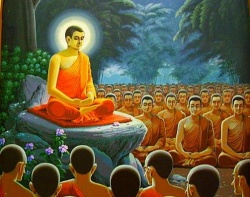Yelpa Yeshe Tsek
Yelpa Yeshe Tsek (yel pa ye shes brtsegs) was born in 1134 in Kham, the son of a lay mantra practitioner named Gompa Ambar (sgom pa a 'bar) and his wife Gongpaza Tsunmacham (gong pa bza' btsun ma lcam), the eldest of four children. Purpa Kyab (phur pa skyabs) or Purpa Drub (phur pa grub) was his childhood name. As a young man he had a meeting with Galo (rga lo) and received teachings from him. Age nineteen, he went to Bamda (rba mda') and took novice vows together with the name Yeshe Tsek. Only one year later he became a full monk.
At first Yeshe Tsek concentrated on learning the monastic discipline texts, and then learned meditation practice, with good results in terms of meditative experiences. As was very common for monks in Kham in those days, in order to further his formal education he traveled to Tibet, at age twenty-three. At first he studied scholastic logic and Madhyamaka philosophy with Chapa (phywa pa). He was dissatisfied, feeling that much of what he was being taught was not really Mahāyāna, and he wanted to learn tantra in any case. So he went first to receive all the empowerments and precepts from Ngok Dode (rngog mdo sde). From Parpuwa Lodro Sengge (spar phu ba blo gros seng ge, d.u.) he received explanations of the doha songs based on a lineage going directly back to Saraha himself.
At age twenty-nine, in 1162, Yeshe Tsek went to Pakmodru together with his teacher Parpuwa. Pakmodrupa Dorje Gyelpo (phag mo gru pa rdo rje rgyal po, 1110-1170) started him out with preliminary practices, then Guruyoga meditations. In the course of his Guruyoga meditations he experienced all phenomenal objects fading into mist. One day while meditating it occurred to him that the time for the noon meal had arrived, and just as he was putting away his meditation band he realized the true meaning of the Madhyamaka view. After a few days pondering its significance he reported this to Pakmodrupa who was quite pleased. Over a period of seven years he was able to hear all of Pakmodrupa's teaching. At their parting he said,
In every way and every time I am protected by the Lama's light. May the Lama bless me that I never for one second be deprived of the state of Voidness-compassion. May I be free from grasping to the illusory bodily aggregate, may I resolve all reifications back into mind, may all my deeds work toward Dharma and may I act constantly for the benefit of beings.
The whole group of disciples saw him off, accompanying him part way on his journey. At one point they made a pile of their outer robes for him to sit on and asked for his teachings before taking their leave.
Back in his home region of Kham, he spent a few years going from place to place. When he was thirty-eight, in 1171, he founded the monastery of Yelpuk (yel phug) and there he headed the assembly for eighteen years. In 1175 he founded Gonlung (dgon lung) Monastery. Then in 1188 a patron made an offering of a monastery in the Nangchen (nang chen) realm that would be called Tana (rta rna), which means ‘Horse Ear,' where he gathered many students. At the time a fellow disciple of Pakmodrupa named Marpa (smar pa) was staying nearby at Sho (sho) Monastery. They met for discussions and exchanged teachings. Then in 1192 still other patrons permitted him to found the monastery of Tojang (stod 'jang), also known as Dodzong (rdo rdzong). During his years residing at these four monasteries he wrote many songs, prayers and treatises, although sad to say hardly any of these writings are available today.
When he was sixty-one he gave his last teachings to his students on the topics of impermanence, the certainty of death, and the faults of samsara. His final words were these, “Never at any time allow yourselves to be deprived of voidness-compassion.” His cremation took place at Tana Monastery. His heart, tongue and eyes remained untouched by the fire, and there was a large pile of ringsel. The monasteries he founded were cared for by his disciple Khenchen Puwa (mkhan chen phu ba). Tana Monastery in Tibet has recently been rebuilt, and a second Tana Monastery has been founded in South India (at Kollegal, in Karnataka State). Tana has long been a famous pilgrimage place among Tibetans because it housed the relics of the national epic hero Ling Gesar (gling ge sar).
Sources
Roerich, George, trans. 1996. The Blue Annals. 2nd ed. Delhi: Motilal Banarsidas, pp. 566-8, tells his life only within the context of the life of his teacher Parpuwa (spar phu ba).
Tshe dbang rgyal. 1994. Lho rong chos 'byung. Lhasa: Bod ljongs bod yig dpe rnying dpe skrun khang, pp. 824-31.
Dan Martin August 2008

